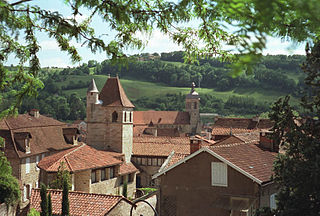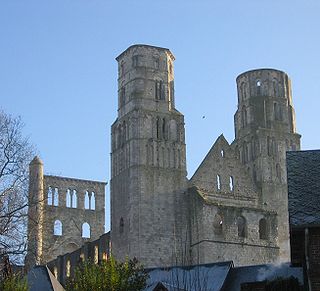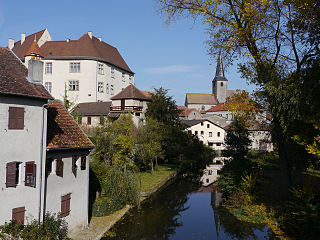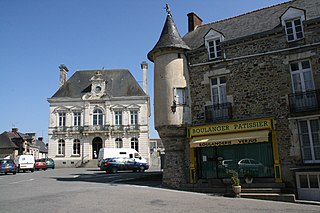
Cruas is a commune near the river Rhône in the Ardèche department in southern France.

Figeac is a commune in the southwestern French department of Lot. Figeac is a sub-prefecture of the department.

Sarlat-la-Canéda, commonly known as Sarlat, is a commune in the southwestern French department of Dordogne, a part of Nouvelle-Aquitaine. Sarlat and La Canéda were distinct towns until merged into one commune in March 1965.

Jumièges is a commune in the Seine-Maritime department in the Normandy region in north-western France.

Sainte-Orse is a commune in the Dordogne department in Nouvelle-Aquitaine in southwestern France. The church of Saint Ursus dates from the 11th-12th century. The castle dates from the 15th-16th century.

Fénétrange is a commune in the Moselle department in Grand Est in north-eastern France.

Vif is a commune in the Isère department in southeastern France.

Janzé is a commune in the Ille-et-Vilaine department in Brittany in northwestern France. It is also the seat of the Canton of Janzé. The inhabitants of Janzé are called Janzéens in French.
Sioniac is a commune in the Corrèze department of Nouvelle-Aquitaine region in central France.

Granges-d'Ans is a commune in the Dordogne department in Nouvelle-Aquitaine in southwestern France. As part of the Pays d'Ans, it shares a link with the neighbouring communes of Badefols-d'Ans, La Boissière-d'Ans, Chourgnac d’Ans, Sainte-Eulalie-d'Ans and Saint-Pantaly-d'Ans.

Saint-Amand-de-Coly is a former commune in the Dordogne department in Nouvelle-Aquitaine in southwestern France. On 1 January 2019, it was merged into the new commune Coly-Saint-Amand.

Saint-Chef is a commune in the Isère department in southeastern France.

Saint-Céré is a commune in the Lot department, southern France. The commune includes within its borders the castle of Saint-Laurent-les-Tours, where the artist Jean Lurçat lived and worked for many years, and from which he operated a secret radio for the French Resistance. The castle still houses a collection of his works.

Cuncy-lès-Varzy is a commune in the Nièvre department in central France. It is located 6 km northeast of the town of Varzy and 15 km southeast of Clamecy.
Gouffern en Auge is a commune in the department of Orne, northwestern France. The municipality was established on 1 January 2017 by merger of the former communes of Silly-en-Gouffern, Aubry-en-Exmes, Avernes-sous-Exmes, Le Bourg-Saint-Léonard, Chambois, La Cochère, Courménil, Exmes, Fel, Omméel, Saint-Pierre-la-Rivière, Survie, Urou-et-Crennes and Villebadin.

Romanesque architecture appeared in France at the end of the 10th century, with the development of feudal society and the rise and spread of monastic orders, particularly the Benedictines, which built many important abbeys and monasteries in the style. It continued to dominate religious architecture until the appearance of French Gothic architecture in the Île-de-France between about 1140 and 1150.

Église Saint-Martin is the parish church of the small commune of Marmoutier, in the Bas-Rhin department of France. The church used to belong to Marmoutier Abbey and to be dedicated to Saint Stephen; it is still known as église (church), or abbatialeSaint-Étienne.
Preuilly Abbey was a Benedictine monastery in Preuilly-sur-Claise, Indre-et-Loire, France. The surviving abbey church retains many Romanesque features, notably the intricately carved capitals.

Château Cramirat is a 12th-century Templar castle in the village of Sergeac, Dordogne (Nouvelle-Aquitaine), southwest France. A French national historic monument, the château is situated in the heart of the Vézère river valley, a UNESCO World Heritage Site known as the Valley of Mankind.





























